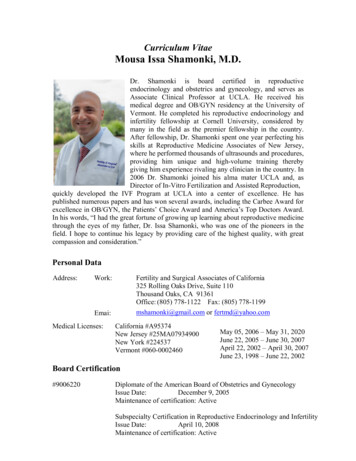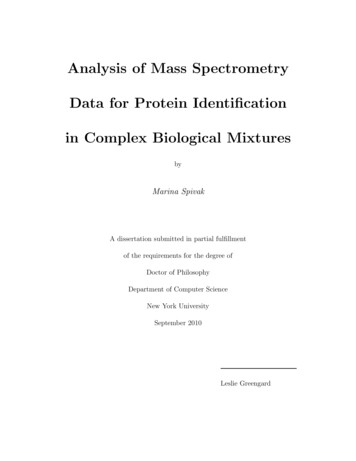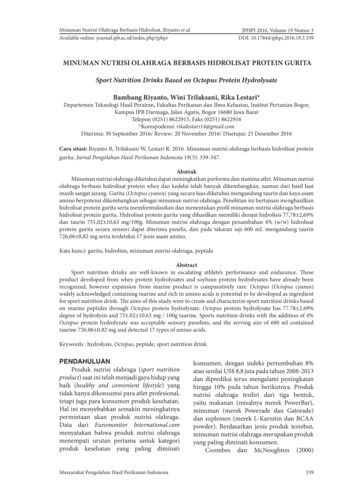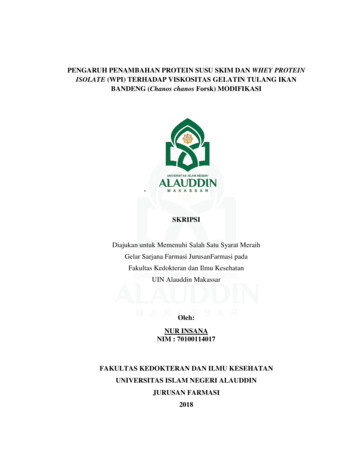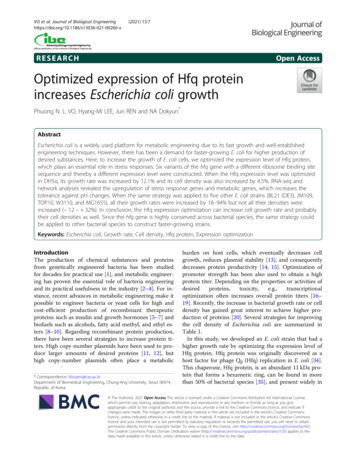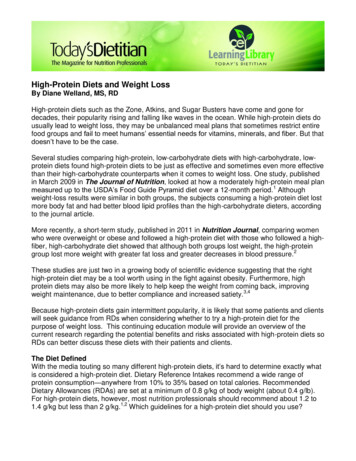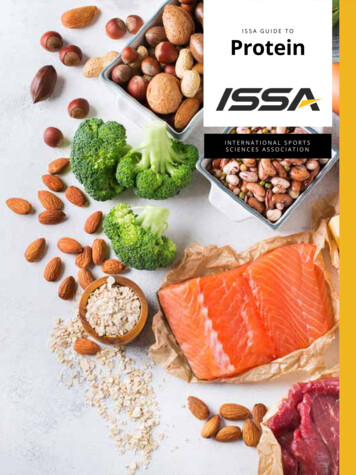
Transcription
ISSA GUIDE TOProteinINTERNATIONAL SPORTSSCIENCES ASSOCIATION
C ontentsContentsYou Have Questions.We Have AnswersProtein Supplements Vs. Protein Foods!Best time to Consume Protein?ISSAONLINE.EDU2
Y ou have questions?BY PAUL HOVAN JR.You have questions . . . . .We have answersPaul Hovan Jr answers your most common questions about protein.When calculating total proteinrequirements, is it dependent on totalbody weight or just lean body mass?requirements on a “per kilogram of lean body mass”basis. If a person weighs 350 pounds, but most ofthat is fat tissue, there is no reason for them to eat350 grams of protein per day; that would be overkill.In most cases, protein requirements are given ona “per pound” basis, meaning total body mass.So if a trainer tells you, “I’ve been eating 1 gramof protein per pound of my body weight and Iweigh 200 pounds,” that means he is eating 200grams of protein. He is not taking into accounthis lean body mass, which is less than 200.So, to summarize, if you are in the “specificpopulations” category, such as an extremely leanathlete, or dieting to achieve a very low percent bodyfat, or are heavily overweight or obese, considercalculating your protein requirements accordingto your lean body mass, not total body weight.For the general population, calculating proteinintake per pound of total body mass is probablyreasonable, but for specific populations, it isn’t asreliable. There have been studies showing that theleaner an athlete is, the more protein he or sheneeds to maintain muscle mass. A study in 2011found that the leaner the athlete was, the moreprotein she required to prevent muscle loss (1).To find out your lean body mass, you need to firstmeasure your body fat. You can have a professionaltrainer measure it with skin fold calipers or use ahandheld electrical impedance monitor—althoughthese aren’t the most accurate. If you have auniversity nearby and are willing to spend a fewbucks, you can see if they have a BodPod device,which uses air displacement for better accuracy.(These are very accurate—DEXA is the gold standard).Another study, from 2013, also found that proteinrequirements for maintaining muscle mass increasedin individuals who became leaner through caloricrestriction (2). This study suggests that whiledieting, lean athletes need 2.3 – 3.1 grams ofprotein per kilogram of lean body mass (LBM).It’s also important to remember that overweightor obese individuals need to consider proteinISSAONLINE.EDUOnce you know your body fat percentage, youcan easily determine how much of your bodyweight is lean mass and how much is fat mass.For example, if you weigh 200 pounds and youfind out that you have 20% body fat, you have40 pounds of fat. Subtract 40 pounds from 200,and you have 160 pounds of lean body mass.3
Y ou have questionsIf I eat too much protein, will theexcess be turned into body fat?First let’s assume that your maintenance amount ofcalories—the number of calories you need to eat perday to maintain your current body weight—is 2,000calories. Let’s also assume that you have met your2,000 calorie goal by the end of the day, with a mix ofprotein, fat, and carbohydrates. Before bed, you decideto have a protein shake consisting of 50 grams of wheyisolate. What will happen to those 200 Calories (50 gprotein x 4 calories/gram) that are now in excess, sinceyou’ve already met your maintenance level of calories?If your body has used all the protein it needs forgrowth, recovery, catalyzing chemical reactions,transporting molecules, and all the other physiologicalfunctions proteins are used for, the excess will bebroken down into amino acids and then convertedinto glucose by a process called gluconeogenesis.Once the amino acids have been converted intoglucose, your body will either: a) use that glucose forimmediate energy, b) store that glucose as glycogento be used as energy at a later period, or c) store theglucose as body fat in the adipose tissue since allglycogen stores are maxed out. (The liver can storeabout 100 grams of glucose in the form of glycogenand the muscles can store about 500 grams.)A study done in 2012 by Bray et al concluded thatthe extra calories from protein ingested by researchparticipants were used to build new lean body mass,although all three groups gained the same amountof body fat. According to the study author, “caloriesalone contributed to the increase in body fat. Incontrast, protein contributed to changes in lean bodymass, but not to the increase in body fat.” (3)We can reasonably state that the additional proteinthe participants ingested was, indeed, needed forgrowth and recovery (shown by the increase inlean mass). However, if no additional protein wasneeded for these actions, the body would eitheruse the protein as immediate energy once theamino acids were converted into glucose, storethe converted glucose as glycogen for later use,or store the converted glucose in the adipose cells(fat tissue), since all glycogen stores were full.which is why, most of the time, whey concentratesare the cheapest, and you get what you pay for. Whey protein isolate. This is a purer proteinpowder. By law, whey isolates must be at least90% protein by weight. The filtration processof isolates is completely up to the supplementcompany manufacturing the protein, butthe biggest difference between concentrateand isolate is the percentage of protein perscoop. Isolates are more expensive and it’s upto you to decide they are worth the money,based on the protein to calorie ratio. Whey protein hydrolysate. This is significantlydifferent from concentrates and isolates whenit comes to processing. Hydrolysate proteinsare treated with enzymes and acids to reduceparticle size and eliminate the quaternary proteinstructures. This is why whey protein hydrolysateis the fastest digesting protein powder; the needfor gastric digestion has been eliminated.Does the type of protein I consumematter (plant protein powderVS whey VS whole food)?Personally, I am an advocate of whole food over proteinpowders. This is how I eat and how I train my clients. Ionly use powders for convenience or quick substitutesfor the clients who have crazy schedules. I believe thatthe less processed something is, the better it is for yourbody. With that said, I’ll briefly touch on the differences. Whey protein concentrate. This is usually themost basic form of protein powder. The proteinsupplement labeled as a concentrate, by law, mustbe at least 35% to 80% protein by weight. It’s asimple procedure to process a whey concentrate,ISSAONLINE.EDU4
Soy protein. This type of protein is heat treatedbefore it is sold, destroying enzymes in the soy,cleansing the powder of trypsin inhibitors. Thesoy isoflavones contained in the powder aren’t a“huge” concern, but they can present a hormonalimpact in men—by increasing estrogen. However,most of the concerns about soy are overblown. Plant-based protein. This is the perfect choicefor vegans and vegetarians. The only issue withplant-based proteins is that most are not completeprotein sources, meaning they lack some of theessential amino acids. You can make up for thislack by combining it with certain other foods.Can too much proteincause kidney stones?As I mentioned in our previous article, excessprotein can boost levels of uric acid, which has beenshown to contribute to kidney stones. However,there is no evidence that elevated protein intakein healthy people will cause kidney damage.Only when a person already has problems withtheir kidneys is caution needed. If you have hadkidney stones before, you are more likely to getthem again. Most kidney stones occur when calciumcombines with either oxalate or phosphorous. I’mnot a doctor, but to quote Dr. Melanie Hoenig, anassistant professor of medicine at Harvard-affiliatedBeth Israel Deaconess Medical Center, some ofthe best ways to prevent kidney stones are:“Drink plenty of water (drinking extra water dilutesthe substances in urine that lead to stones), ensuresufficient calcium intake (too little in your diet cancause oxalate levels to rise and cause kidney stones),limit animal protein (a high-protein diet can reducelevels of citrate, the chemical in urine that helpsprevent stones from forming), and avoid stone-formingfoods (such as beets, chocolate, spinach, rhubarb,tea, and most nuts – which are rich in oxalate.)” (5)Just because your diet doesn’t consist of any meat,doesn’t mean you need more protein than theperson eating chicken, eggs, and red meat everyday. A vegan athlete’s protein needs can rangefrom 0.36 to 0.86 grams per pound of body weight(6). The RDA is definitely on the safe side andas I mentioned in our previous article, athletesand resistance exercisers will need more totalprotein than the average, sedentary individual.Y ou have questions Total protein intake can easily be achieved whilefollowing a vegan or vegetarian diet. Nearly allbeans, vegetables, grains, and nuts contain protein.Although they may not be complete sources ofprotein, you can combine foods, such as rice andbeans, to create a complete protein meal.I recommend that vegans and vegetarians eat adiet with a variety of unrefined grains, legumes,nuts, seeds, and vegetables so that if one of yourfood choices is low in amino acids, the other willmake up for that deficit. Please look back at ourfirst question of this article to determine how youshould calculate your daily total protein needs.References1.Journal of Sports Sciences: Dietary Protein for Athletes:From Requirements to Optimum Adaptation2.Journal of Sports Nutrition and Exercise Metabolism: ASystematic Review of Dietary Protein During Caloric Restrictionin Resistance Trained Lean Athletes: A Case for Higher Intakes3.Bray GA, Smith SR, de Jonge L, Xie H, Rood J, MartinCK, Most M, Brock C, Mancuso S, Redman LM: Effectof dietary protein content on weight gain, energyexpenditure, and body composition during overeating:a randomized controlled trial.JAMA 2012, /protein.phpDo vegetarians and vegansneed more protein?This was a great question, but I think you’ll goingto be surprised at how simple the answer is:Vegans or vegetarians don’t need any more proteinthan a person following a “meat heavy” diet. Therecommended dietary allowance (RDA) is 0.8 gramsof protein per kilogram of bodyweight—and that’s forEVERYONE— vegans, vegetarians, and meat-eaters.I have read recommendations that vegetarians andvegans should eat 10 percent more protein thanmeat-eaters, but this is based on the flawed idea thatbecause they aren’t eating animal protein the completesources of protein—that they need more total protein.ISSAONLINE.EDU5
KNOW IT ALLKnow It AllISSA’s Fitness Nutrition CertificaitonEverything you need to know to deliver life-changing results foryourself and your clients by mastering the art and science ofnutrition coaching.issaonline.eduISSAONLINE.EDU6
PROTEIN SUPPLEMENTS VS. PROTEIN FOODS!BY PATRICK GAMBOAProteinSupplementsVs.ProteinFoods!Many aspiring bodybuilders are hoping that this is the year that their bodieswill transform into the bodies of their dreams. Unfortunately, bodybuilderslove for protein puts them at the mercy of protein manufacturers andvulnerable to protein manufacturers marketing ploys. Fledgling bodybuildersmay not know as much as veteran bodybuilders but they inevitablyknow that protein plays a role in their future bodybuilding success.Where should this protein come from? To answer this question, we willlook at the role of protein in foods versus protein supplementation.Protein ManufacturersPick up any publication devoted to health and fitness and you will beinundated with articles on protein. Protein manufacturers are notoriousfor throwing around words like cross flow microfiltration, oligopeptides, ionexchange, protein efficiency ratio, biological value, nitrogen retention andglycomacropeptides as a way to convince potential buyers. It sure soundsconvincing, especially when scores of scientific references are cited. Likemost aspects of bodybuilding (and the supplement industry in general),marketing hype rather than physiological reality drives the issue of protein.Many nutrition “experts” (people who sell supplements), state thatthere are distinct advantages of protein supplements: powdersand amino acid tablets over whole foods. There are many differentmethods of determining protein quality, including biological value(BV), Protein efficiency ration (PER), Net Protein Utilization (NPU),and protein digestibility corrected amino acid score (PDCAAS).ISSAONLINE.EDU7
BV is one of the most commonly used and is arguably,the best measure of a protein’s quality. BV is basedon how much of the protein consumed is actuallyabsorbed and utilized in the body. The higher theamount of protein (nitrogen) that is actually retained,the greater the BV. If a protein has a BV of 100, it meansthat all of the protein absorbed has been utilized withnone lost. Whole eggs score the highest of all foodswith a BV of 100, while beans have a BV of only 49.Protein quality is certainly an important issue, but itis one that has been enormously overstated and evendistorted for marketing purposes. Whey protein istruly an excellent protein with a biological value at ornear 100. Many advertisements will have you believethat their whey is between 104 –157 on the BV scale.In “Advanced Nutrition and Human Metabolism”, BV isdefined as “a measure of nitrogen retained for growthand/or maintenance that is expressed as a percentage ofnitrogen absorbed.” When a protein supplement is listedas having a BV over 100, the company has intentionallymanipulated the number for marketing purposes. Thecompanies are usually making reference to the chemicalscore of the protein. Chemical score is a comparison ofthe amino acid pattern in an ideal refere
1.ournal of Sports Sciences: Dietary Protein for Athletes: J From Requirements to Optimum Adaptation 2. Journal of Sports Nutrition and Exercise Metabolism: A Systematic Review of Dietary Protein During Caloric Restriction in Resistance Trained Lean Athletes: A Case for Higher Intakes 3. Bray GA, Smith SR, de Jonge L, Xie H, Rood J, Martin


